Roccat Sova Mechanical Gaming Lapboard Review
Pros
Cons
Rating
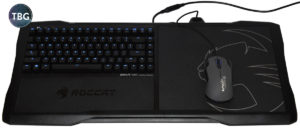
Introduction
Here at TBG, we’ve tested lots of keyboards. From compact models for home theater use to RGB mechanical gaming keyboards that virtually glow in the dark, we’ve pretty much seen them all. Well, we thought we had. Turns out that Germany-based Roccat has been busy one-upping the competition when it comes to innovation. We were lucky enough to catch up with Roccat at PAX West 2016, and they generously offered to let us in on their newest keyboards. We’ve of course known of Roccat for years, but up until now hadn’t reviewed any of its peripherals. We were therefore eager to see how Roccat’s product line stacked up against Corsair, Logitech, and Razer, companies that dominate the gaming peripherals market, at least in terms of marketing.
The product we’ll be focusing on primarily in this review is the Roccat Sova Mechanical Gaming Lapboard, which is one of several new gaming peripherals targeted at former console gamers looking to make the leap to PC gaming while still firmly planted on the couch. Roccat has some big-name competition in this arena in the form of the $120 Corsair Lapdog and the $160 Razer Turret. Roccat has little to fear from these devices, though, as each is so poorly designed that it’s a wonder either got past the modeling stage. The Lapdog is hopelessly overpriced, given its lack of any included hardware, and the placement of the keyboard at the wrist-edge of the device is a terrible design choice. Meanwhile, the Turret offers a ludicrously-small mousing surface, making it clear that gaming is not its intended purpose; decorating your TV room with flashing green lights is. In other words, we’re going to be judging the Sova on its own merits, rather than spending a lot of time demonstrating how it beats the competition.
Roccat was also keen to have us test out the brand-new Roccat Skeltr, which as of our publication date is still in limited release. Its claim to fame is an integrated Bluetooth module allowing it to interface with smartphones and tablets as a typing device. It is not, however, able to do so for PCs, as it must be plugged into a PC for power, meaning any wireless connection would be duplicative. We’ll be touching upon the Skeltr’s virtues and vices on the second page of this review, but in short, it seems that Roccat is not quite immune to the foul ball syndrome that clearly afflicts Corsair and Razer when swinging for the fences with new designs.
We’d like to extend a special thank you to Roccat for providing us with a review sample of the Roccat Sova Mechanical Gaming Lapboard and Roccat Skeltr RGB Keyboard, along with the Roccat Kova Gaming Mouse used for testing.
Description and Features
The Sova is a big device, measuring about 25.5″ wide and 11″ deep at its largest points, and just under two inches thick (including lap pads but not including keys). The wrist rest spans the entire width of the tenkeyless keyboard, and is 3.5″ deep. The mouse pad is a very healthy 9″ tall by 11″ wide, meaning it’s totally legit when it comes to actual gaming, unlike the mousing surfaces on some of its lapboard competitors. Of course, the generous proportions of the Sova comes with a penalty, in the form of a 5 pound, 11 ounce weight. That figure is pretty significant when the keyboard is sitting on your lap, and it’s one reason that we might need to do the unthinkable and suggest the membrane-based Roccat Sova model over the mechanical version we tested. It’s about 8 ounces (or half a pound) lighter. We’ll say a bit more about the performance of the TTC mechanical switches used in our sample on the next page.
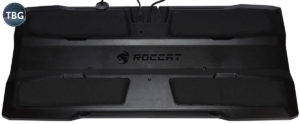
The bottom of the Sova is where Roccat’s attention to detail is clearly demonstrated. Four removable lap cushions provide ample footing for the board, and two USB 2.0 jacks allow users to connect not just a mouse, but a USB headset as well (analog models are not supported). Along with the handy mouse cord clip on the backside of the keyboard, these components make it clear that Roccat thoroughly considered the basics before releasing this board.
Another feature that the Sova offers is blue LED backlighting, which can be set to one of six brightness levels. These settings are available on a per-key basis with the Sova Mechanical, allowing rolling blue light shows, one advantage it has over the Sova membrane model. Given that RGB lighting is all the rage, it’s perhaps a bit surprising to see a premium offering with single-color LEDs, but we don’t really consider this a major issue. Given that the Sova will likely be used in a darkened entertainment room, the single-color backlit keys are truly functional, and wouldn’t be any more functional if they showed off every color of the rainbow. Unfortunately, our sample board had a dead LED under the “End” key, which can be seen if you look carefully at our product images. We assume Roccat would repair this under warranty if it ended up in the hands of a consumer in this condition, but shipping this big board back and forth would be costly.
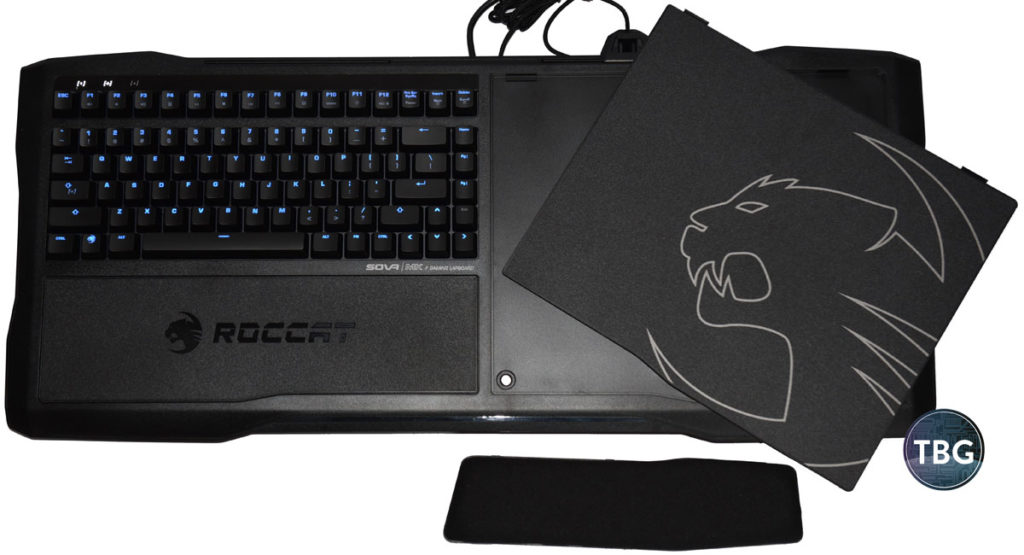
In the photo above, we’ve broken down the Sova into some of its constituent parts. We removed one of the four lap pads, which allowed us to pop off the magnetically-attached mousing surface. These parts can be replaced over time, at least in theory. By the way, we’ve seen promotional images on the Roccat website as well as store websites showing off a smartphone cradle. We really wish this image weren’t provided to stores, because it’s not actually included in the package, nor does it seem to be available as of our publication date. The Roccat website notes that this is an optional accessory (although there’s no indication of how to procure one), but store websites haven’t picked up on that important detail. Roccat should seriously consider removing this photo from the product images provided to stores, as it’s extremely misleading. And honestly, it’s a shame this smartphone holder isn’t included in the box, as it would be a nice addition to the package for couch gamers.
Performance
Moving onto performance, we were immediately impressed at the excellent balance provide by the Sova’s long, wide base and four lap cushions. While a lap-height keyboard isn’t exactly ergonomic, it’s pretty much the best option for couch gaming. We were also very impressed with the TTC mechanical switches. We mentioned on the previous page that they add quite a bit of weight (around 1/2 a pound) to the Sova platform, and given that the device is sitting on your lap, that weight can unfortunately be felt. Luckily for mechanical switch fans, the weight penalty may in fact be worth it. The TTC switches, which we believe are proprietary to Roccat, provide truly excellent feedback and response. We’d liken them most to Cherry MX Brown switches, which happen to be our very favorite switches. Unlike the Cherry MX Red switches and assorted clones from other manufacturers, the MX Brown-type key provides a tactile bump that really aids in typing. For gaming, it’s not quite as critical, however, so whether this feedback is a true selling point for a keyboard product that will almost certainly not be used for productivity is questionable. All things being equal, though, we like this switch choice on Roccat’s part, and commend Roccat for coming up with a switch that can rival Cherry. And yes, mechanical switches of any kind are always preferable to membrane switches, even for gaming.
But all is not perfect with regard to performance. The mousing surface and the wrist rest appear to be made of the same textured hard plastic, and frankly, it’s an odd choice of materials for either. While textured hard plastic mousepads are great for ultra-twitch gaming, they tend to wear down the glide pads on mice more quickly, and in the case of the Sova, are simply too slick. We found the mouse sliding all over the place the moment we took our hand off of it, due to the slight incline (or decline) at which the Sova was sitting at any particular moment. Likewise, the hard plastic doesn’t translate to what we’d consider a particularly comfortable wrist rest. Given the modularity of the Sova, we hope that in the future Roccat offers upgrades for the Sova, rather than just replacements parts. Roccat should absolutely consider offering aftermarket add-ons such as a slighty-raised, padded wrist rest as well as a cloth mousing surface, rather than the hard plastic ones the Sova is currently shipping with. Better yet, Roccat might do well to release a new Sova model with these accessories included right in the box. While it’s still a step ahead of the slow-footed competition from Corsair and Razer in this regard, neither of which even includes a wrist rest, just beating them is not enough. Roccat could slam the door shut with better material choices.
One other minor issue with regard to usability is the somewhat unusual layout of the tenkeyless board. The delete key, which we often use while writing articles, is positioned way up in the function key row, while the Home and Page Up key reside in the general vicinity of where the delete key would typically be found. This led to a whole lot of inadvertent page jumps while touch typing on the Sova. As we’ve emphasized already, the Sova was likely never meant to be a major productivity tool, so it’s unlikely that users will find this odd layout all that troublesome.
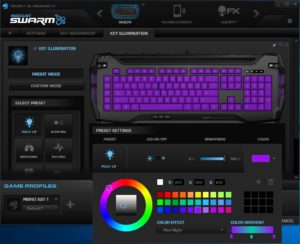
The Roccat Swarm App and the Roccat Skeltr RGB Keyboard
Nowadays, no discussion of gaming peripherals can be considered complete without delving into the software suite used to control all the whiz-bang effects. We’ve included a screenshot of the Roccat Swarm app in use with the Skeltr keyboard, which offers a bit more customization than the Sova. The Skeltr has RGB lighting, making our Swarm screenshot a bit more “photogenic.” The Sova is pretty light on effects due to the lack of any color choice, although you can select from a few cool modes, our favorite being “Impulse”, which sets the backlight to dim, and then lights up each key as you strike it, harnessing the Sova Mechanical’s per-key lighting system. As with most keyboards, you can program keys to open certain applications, and there are even Macro options, although without dedicated Macro keys, this may be of limited use. Overall, the app is pretty slick, although we were surprised by the number of updates it required over the course of a week or so of testing. We were also a bit disappointed when it crashed while selecting colors for various lighting zones on the Skeltr sample we had.
Speaking of the Skeltr, we’ll provide a brief review here. Originally announced way back in 2014, when tablets were poised to take over the world, the Skeltr seems to be a bit of an anachronism in today’s market. With a retail price of $160, it’s extremely expensive for a membrane-based keyboard, even one with RGB backlighting. In the intervening two years, several major manufacturers have introduced membrane-based keyboards that offers superior zoned or per-key RGB lighting for a lot less. For example, Logitech has recently introduced the G213 Prodigy Keyboard at $70, while Cooler Master has its MasterKeys Lite mouse and board combo at $60. Each has five programmable color zones. The Skeltr has five zones too, but in reality this is more of a marketing point than anything users will get excited about. The keyboard itself consists of only a single zone, with four ambient side lights representing the other four zones. That means there’s very little in the way of customization available; the photo below basically sums up the extent to which lighting can be customized. It’s limited, and to make matters worse, in a few instances, the main zone would go dark after waking from sleep, leaving only the ambient zones illuminated.
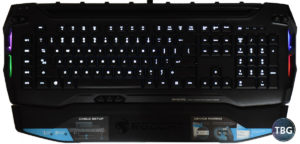
The big new feature that the Skeltr offers over the competition is Bluetooth integration, which is used to allow for mode switching between PC and smart device typing. While the keyboard must always be hardwired to your PC via USB, with the press of a button, you can switch the keyboard output to a Bluetooth-connected smart device, allowing you to type a text message or e-mail on the device without picking it up. The Skeltr has an integrated rubber-coated slot on the back edge that should securely hold any smart device. You can also attach headphones to the Skeltr, and then use these either to listen to or speak through your PC, or alternatively to speak through a smartphone.
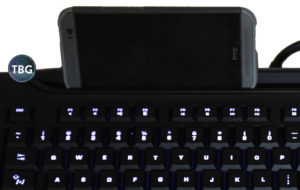
Confusingly, the Bluetooth connection cannot be used for audio, and we assume this is due to limitations inherent in the Bluetooth standard, which likely never conceived of a keyboard that could also be used as a headset. Alas we found the cabling cumbersome (one cable is required for audio, one for charging). We didn’t even bother including the cables in the photo of the smartphone mounted shown here, as the rat’s nest it created just didn’t look all that great. We were also surprised that the charging circuit on the Skeltr was barely able to keep up with battery drain on our smarthphone. Over the course of several hours, it only added about 15% to our phone’s battery level.
The final nail in the coffin for the Skeltr is that its membrane-based keys feel mushy, just like a standard $60 keyboard. That’s fine if you’re paying $60, but paying $160 for the Skeltr doesn’t seem to make much sense unless you’re a hard-core smartphone user who needs instant access to texting while gaming on your PC. We think that’s a pretty niche market. Simply put, at this pricepoint, the Skeltr should absolutely include the excellent TTC switches featured in the Roccat Sova we tested. That would make for a very marketable $160 keyboard, even with the other limitations we’ve noted regarding phone integration and RGB lighting. As it stands, we cannot recommend the Skeltr, and we’ve communicated this to Roccat along with our suggestions for improvements.
Conclusion
Circling back to the Sova Mechanical, we’re happy to report that save for a few minor issues, this lapboard represents a serious home run in terms of innovation. Offering a quality keyboard and a high-performance mouse pad, along with a finely-balanced layout, the Sova is truly the best-of-breed when it comes to gaming lapboards. If you’re a PC gamer looking to get your first-person shooter fix while planted on the couch, the Sova is your only true option. Gamepads are great for some games, but in any game requiring precise aim, they are essential useless; a mouse is essential. And there is no other keyboard/mousepad combo on the market today that’s even remotely competitive with the Sova. Roccat should be proud of its work designing a cutting-edge device that does so much so well right out of the gate. Over time, we’re sure Roccat will be able to offer up a few refinements, but as it stands, the Sova is definitely worthy of consideration.
The standard membrane-based Roccat Sova is available for $149.99 as of our publication date, while the Roccat Sova Mechanical is available for $199.99. That extra cost includes the superior mechanical keys and the per-key lighting they provide, along with a 1/2 pound of extra weight. We think that for most couch gamers, the membrane version will probably be preferable. The Roccat Skeltr is available for $160, but as we mentioned above, it doesn’t get our recommendation here.
We’re happy to report that the Sova “made the grade” and has now been added to our Peripherals Buyer’s Guide, updated quarterly with the very best gear on the market!

